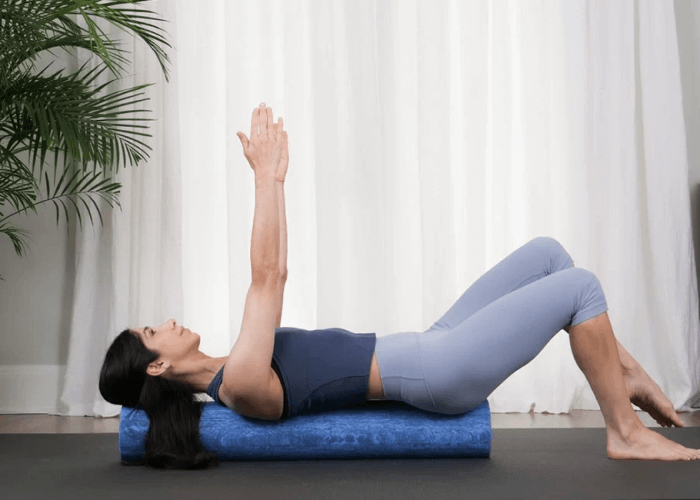Breathe Your Way To Better Health

We do it ALL. THE. TIME.
You. The people around you. The people you love. But are we doing it well?
Breathing is something we take for granted. It’s one of those things in life that you don’t appreciate until you realize something is off. Are you breathing to promote good health, or could you unintentionally shorten your lifespan with every inhale?
This article explores how healthy breathing patterns can help you reduce stress and live better.
Why is it Important to Breathe Correctly?
Our attention to the act of breathing has been in the spotlight since the onset of the pandemic. The media coverage of the tragedies in critical care units worldwide has brought one of our most vital functions to the forefront.
Even if you have been fortunate to avoid COVID-19, checking in with your breathing pattern is still imperative. It is the underpinning of every system in our bodies and can promote a vibrant, healthy physical and mental state as well as contribute to the opposite.
On the most fundamental level, healthy breathing maintains the correct balance between oxygen and carbon dioxide. Proper breathing patterns help us achieve this in real-time.
In a healthy breathing pattern, our primary breathing muscle — the diaphragm — descends on your inhale and rises on your exhale, helping to create intra-abdominal pressure.
This makes a constant massaging action on all of your organs, filling them with fresh blood, fluids, and oxygen, as well as creating a gentle tug and release action on your heart through fascial connections.
On the other hand, unhealthy breathing patterns (such as mouth breathing or shallow breathing) trigger your sympathetic nervous system to pump stress hormones into your body.
Shallow breathing can turn into panic attacks, cause dry mouth and fatigue, aggravate respiratory problems, and is a precursor for cardiovascular issues.
The good news is that controlling your breath can help reduce or eliminate these symptoms!
Studies have shown that many people who practice yoga, particularly those who focus on the practice of Pranayama, or breath control, can regulate their sympathetic nervous system also known as your “fight or flight” response.
This is why taking the time to breathe correctly is so important for maintaining regular body functions as well as better well-being.
What Is a Healthy Breathing Pattern?
A key aspect of healthy breathing is inhaling through the nose rather than the mouth.
When we take air into the nostrils, tiny hairs and a light mucous coating in passageways called turbinates help catch dust, bacteria, and other irritating particles. This also allows the air to humidify and warm to body temperature. In addition, nitric oxide, a vasodilator, widens the blood vessels and allows for better oxygen delivery to all of your cells.
Your respiratory rate — known as your breathing rate — refers to this cycle. It is the number of breaths you take per minute. You can measure your breathing rate by counting the number of breaths you take over the course of one minute while you're at rest.
A resting respiratory rate of between 12 to 20 breaths per minute is considered normal, while anything above or below is abnormal and should be investigated.
Yoga and Pilates practitioners often have a lower breathing rate. For example, as a yoga and Buteyko Breathing Method trained instructor, along with my Pilates education, I aim for a breathing rate between 10 to 15 breaths per minute during a more restful state in daily life.
What Causes Dysfunctional Breathing?
Sleep apnea is perhaps the most well-known disruption to normal breathing patterns, but undiagnosed mild hyperventilation during our waking hours often flies under the radar.
Hyperventilation, also called overbreathing, is breathing too rapidly or deeply, taking in too high a volume of air. This can lead to a host of physical and mental symptoms, including anxiety, high blood pressure, and dizziness.
Unfortunately, these symptoms are often misdiagnosed or attributed to other causes when problematic breathing is the true source.
As a former upper chest breather — once put into claustrophobic chambers to test and then be diagnosed with asthma — and someone who suffered panic attacks in my twenties and early thirties, I’ve learned the difference between breathing and breathing well.
I discovered the terrible symptoms I experienced weren’t uncommon at all. It set me down a long and winding path to a deeper understanding of breathing mechanics, the chemistry of breath, and the negative impacts of dysfunctional breathing (DB). I came out on the other side feeling better at 50 than I did in my twenties!
Can Improper Breathing Cause Stress?
It’s important to note that dysfunctional breathing isn’t always caused by a physical ailment. It could be the way you’re breathing.
Our modern-day life with information overload and hurried schedules has too many of us living with a breathing pattern stuck in fight or flight mode triggering the aforementioned sympathetic nervous system.
While these current stresses can affect our respiratory rate, past traumatic experiences can also be an underlying cause of a dysfunctional pattern.
In either case, regularly and consciously bringing the breath back to a better state can play an essential role in healing.
Symptoms of Dysfunctional Breathing
Many things can lead to dysfunctional pattern.
For me, I suspect years of ballet training with the constant cueing to “pull up,” and project to the balcony finally took over and replaced a healthy natural breath. Stress is also a HUGE trigger to over-breathing, as is sitting for prolonged periods.
People who have DB tend to breathe rapidly through the mouth, hold tension in their shoulders and breathe using the upper chest. This can lead to a variety of symptoms, including:
- Feeling short of breath — even though you’re breathing in more volume of air than needed
- Sighing often
- Asthma attacks
- Feelings of anxiousness
- High Blood Pressure
- Digestive Issues
- Rapid Pulse
- Headaches and Dizziness
- Exhaustion
The good news is that there are simple exercises you can use to reduce these symptoms.
Take a soft and slow inhale as we dive into how to improve dysfunctional breathing.
8 Ways to Improve Dysfunctional Breathing
When it comes to improving breathing, I approach it from a holistic point of view rather than using only one method.
While the overall goal is to strengthen the diaphragmatic function and nasal breathing, various techniques to address faulty breathing mechanics provide a better chance to breathe easier.
- Fascia release with soft tools (roller/balls) in areas that are restricting necessary torso expansion
- Addressing alignment issues that could be interfering with nerve innervation of respiration muscles
- Addressing the role of near to far distance focus affecting tension in the secondary breathing muscles (up-close work vs. panoramic focus)
- Making the conscious switch to nasal breathing which naturally reduces breathing volume to a more functional level and increases nitric oxide
- Developing “thought awareness” to identify triggers of poor breathing patterns
- Addressing the modern-day focus on “tight abs,” which causes restriction of diaphragmatic function
- Using yoga pranayama (breathing exercises)
- Using key yoga poses with longer exhales
Try Breathing Classes For Free
I hope this inspires you to take a fresh perspective on how breathing properly impacts overall health and mental wellness.
You can try out my yogic and functional breathing classes in our on-demand library — by signing up for the 7-day free membership trial here.
Cheers to breathing well!
Let's Stay In Touch!




